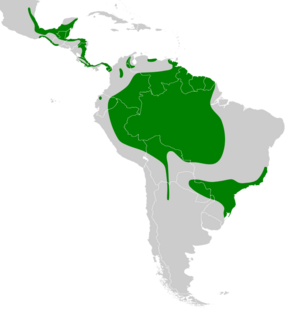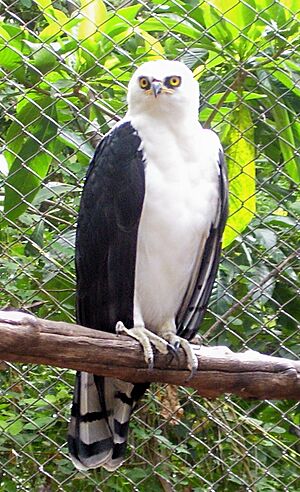Black-and-white hawk-eagle facts for kids
Quick facts for kids Black-and-white hawk-eagle |
|
|---|---|
 |
|
| Conservation status | |
| Scientific classification | |
| Genus: |
Spizaetus
|
| Species: |
melanoleucus
|
 |
|
| Synonyms | |
|
Buteo melanoleucus Vieillot, 1816 |
|
The black-and-white hawk-eagle (Spizaetus melanoleucus) is a cool bird of prey. It belongs to the eagle and hawk family, called Accipitridae. You can find this amazing bird in many parts of tropical America. Its home stretches from southern Mexico all the way down to northern Argentina.
Contents
What Does It Look Like?
As its name tells you, this eagle is mostly black and white! It looks a bit like smaller eagles. This bird is about 50 to 60 centimeters (20 to 24 inches) long. It weighs around 850 grams (30 ounces).
Its head, neck, and body are bright white. It has a small black crest on top of its head. The area around its eyes, especially near its beak, is also black. Its wings are black, but they have a clear white front edge. The tail is brownish with dark grey stripes and a white tip.
Adult eagles have orange eyes. Young eagles have greyish eyes. Their feet are pale to bright yellow with black talons (claws). The beak is black with a yellow cere (the waxy part at the base of the beak).
Male and female black-and-white hawk-eagles look the same in color. However, the female is usually bigger than the male. Young birds have lighter edges on their upper wing feathers. They also have some brownish-grey feathers on their back.
It's hard to confuse this eagle with other birds. But young Grey-headed Kites can look similar. The black-faced hawk is also very similar in color. But it's much smaller and has a black tail with one bold white stripe. The ornate hawk-eagle looks quite similar when it's young. But young ornate hawk-eagles have much lighter wings, back, and tail. They also don't have the black ring around their eyes.
Where Do They Live and What Do They Eat?
This eagle lives in many places across Central and South America. You can find it from southern Mexico through Central America. It also lives along the Caribbean coast in northern Colombia and Venezuela. From there, its range goes south through eastern Brazil, Paraguay, and Uruguay to northeastern Argentina. There's also a group of these eagles in northeastern Peru.
Their Home (Habitat)
Black-and-white hawk-eagles like to live in lowland forests. They don't like very dense, wet forests or dry, savanna-like areas. They need large areas of forest where the tree branches form a thick roof, called a canopy. They don't usually live high up in mountains. But one was seen at about 1,200 meters (4,000 feet) high in Colombia.
What's on the Menu?
This eagle is a carnivore, which means it eats meat. Its diet includes mammals, toads, squamates (like lizards and snakes), and many different kinds of birds. They especially like birds that live in trees, such as oropendolas, aracaris, and tanagers. But they also eat birds that live on the ground or near water, like tinamous and cormorants. They have even been seen attacking small monkeys, though it's not clear if they eat them. They might also eat opossums.
How Do They Hunt?
The black-and-white hawk-eagle likes to hunt by soaring high in the sky. When it spots prey, it dives down very fast. It often dives right into the forest canopy to catch its meal. It has also been seen catching a white woodpecker in mid-air! They like to hunt along the edges of forests. This helps them reach prey both in the trees and on the ground.
Nesting Habits
These eagles build their nests high up in the forest canopy. They use sticks to build their nests in tall, open trees, often on ridges. This gives them a good view of their hunting grounds. We don't have many detailed observations about their nesting habits. In Brazil, a nest was found in 2006. In Belize, two nests were studied in 2009. In Panama, they might start building nests in September. The main nesting season in Central America seems to be from March to June.
Population Status
We don't have a lot of information about how many black-and-white hawk-eagles there are. Each bird seems to need a large hunting area, about 1,400 hectares (3,500 acres). Even though they live in many different types of habitats, they are still quite rare in most places. The IUCN (International Union for Conservation of Nature) used to list them as "Near Threatened." But now, because there's no clear sign of a big decline, they are listed as a species of "Least Concern." This means they are not currently at high risk of extinction.
Their Scientific Name
The black-and-white hawk-eagle's scientific name is Spizaetus melanoleucus. For a while, it was placed in its own group, called Spizastur. But recently, scientists moved it into the group Spizaetus. This is because it seems to be very closely related to the ornate hawk-eagle (S. ornatus).
Sometimes, scientific names can get a bit confusing! The name Spizaetus melanoleucus was first given to a different bird, the black-chested buzzard-eagle, by a scientist named Louis Pierre Vieillot in 1819. But the black-and-white hawk-eagle had been described earlier, in 1816, by the same scientist, under the name Buteo melanoleucus.
Over time, scientists moved these birds into different groups. This meant the names didn't clash. But when the black-and-white hawk-eagle was moved into Spizaetus, it ended up sharing a very similar name with the black-chested buzzard-eagle. Don't worry, scientists have rules to sort out these naming puzzles!



